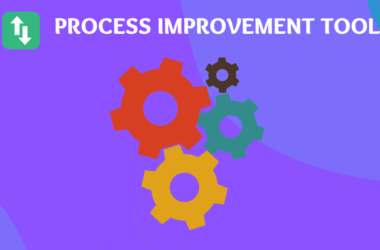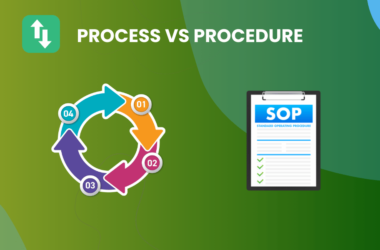Table of Contents Show
Empower your business with task automation, a potent strategy that transforms mundane tasks into avenues for unprecedented productivity growth.
Demystifying task automation, it’s a technology-enabled strategy that allows businesses to streamline and increase the efficiency of their processes. Simply put, it’s the use of technology to take over repetitive, manual tasks with minimal or no human intervention.
Providing a primer for entrepreneurs, task automation is a powerhouse that can unlock previously unattainable productivity levels. By automating tasks, managers can delegate routine jobs to technology, freeing up time to focus on strategy and innovation.
What is task automation?
Task automation embodies the essence of assigning frequent, repetitive tasks to digital systems that carry them out with little or no human intervention. This comprehensive mechanization paves the way for diligent productivity, centering human focus on strategic and creative work.
Task automation is the strategic assignment of routine tasks to automated systems, enhancing productivity by enabling human focus on creative, strategic work.
In essence, task automation is the process where manual functions are transferred to an automated system, undeniably streamlining operations. Imagine an administrative assembly line smoothly carrying out menial tasks with unwavering precision and consistency.
Delving deeper into task automation, it is a strategic utilization of tools, technologies, and systems to execute routine, monotonous tasks. It’s a vital cog in the productivity machine, enabling us to maximize efficiency, ensure quality, and stay focused on the broader business picture.
Why task automation is crucial for productivity?
Task automation emerges as a pivotal game-changer in the productivity landscape. Assigning routine tasks to machines, frees up your valuable time, engaging your resources in strategic endeavors that yield high returns.
Unearthing the pivotal link between task automation and productivity reveals an upward trajectory. Firms employing automation experience quite an increase in operational effectiveness, setting the stage for higher margins.
Productivity undergoes a significant boost when task automation is introduced into the mix. This indispensable tool ultimately becomes the fuel that powers an organization toward achieving its business objectives.
Benefits of Task Automation
Task automation not only heightens efficiency, but it also reciprocates in time savings, a core benefit that enables businesses to reallocate those saved hours towards strategic initiatives.
By stepping up efficiency and reclaiming time, task automation serves as a powerful ally for modern businesses, helping them unlock their true productivity potential.
1. Increased efficiency and time savings
Deploying task automation strategies effectively translates into elevated efficiency, not only by accomplishing tasks rapidly but also by freeing up your valuable time. This time can then be utilized for activities demanding human attention or creativity.
- Optimizing Operational Efficiency: Automated tasks are carried out swiftly and consistently, reducing time spent on monotonous tasks.
- Eliminating Time Wastage: Automation reduces or eliminates the necessity to spend time on repetitive tasks, allowing you to focus on high-value and strategic work.
- Free Up valuable time: Automation enables your workforce to save time, which can be committed to business growth and innovation.
2. Reduced errors and improved accuracy
Task automation is a game-changer for accuracy and error reduction. It reduces the potential for mistakes that can happen with manual operations, thus improving precision in executing tasks.
- Automatic data validation to prevent entry errors
- Strict process adherence enabled by automation rules
- Reduced human error due to fatigue or multitasking
- Consistent and accurate task execution regardless of task volume
3. Enhanced focus on strategic activities
Task automation greatly boosts focus on the strategic tasks vital for growth. By automating routine, mundane tasks, managers and entrepreneurs can center their attention and energy on forward-looking initiatives.
- Maximizing capacity for high-level thinking and planning
- Freeing up time to concentrate on business expansion strategies
- Redirecting resources towards innovation and creativity
- Allowing for deeper engagement in customer relationship management
- Enhancing decision-making processes by reducing mental clutter associated with repetitive tasks
Key Tools for Task Automation
Dive deep into the world of automation and discover superiority. Let’s discuss the heart of task automation – workflow management software, Robotic Process Automation (RPA), and advanced AI and machine learning. They serve as key tools in your automation strategy arsenal to bolster productivity.
1. Workflow management software
Workflow management software plays an instrumental role in task automation, acting as a powerful tool to streamline operations and elevate productivity. It brings together various tasks, processes, and functions into a cohesive whole, facilitating smooth information flow and completion of projects.
- Automation of repetitive and time-consuming tasks
- Interactive dashboards for real-time tracking and monitoring
- Integration capabilities with other business systems and apps
- Saved templates for frequently used workflows
- Timely notifications and alerts to avoid bottlenecks
- Easy delegation of tasks and transparency in team collaborations
- Reporting tools for performance evaluation and insights
2. Robotic Process Automation (RPA)
Robotic Process Automation (RPA), a powerful tech ally in the quest for increased productivity, automates repetitive, manual tasks, freeing up valuable time for businesses to focus on strategic, high-impact duties.
- RPA simulates human interactions with digital systems, managing rule-based and predictable tasks.
- With RPA, there’s a significant reduction in execution time and operational costs.
- Robotic Process Automation helps businesses operate 24/7 without personnel restrictions.
- RPA can be applied across departments, from customer service to finance, enhancing productivity.
3. Artificial intelligence (AI) and machine learning (ML)
Harnessing the proactive power of AI and ML in task automation marks a significant leap in productivity. These advanced technologies can predict processes, pre-empt potential bottlenecks, and initiate corrective actions, enhancing overall workflow efficiency.
Embracing AI and ML signifies stepping into a thrilling era in task automation. By smartly automating complex tasks, they add a novel dimension to your business operations, promising a landscape filled with limitless possibilities and optimized productivity.
Implementing Task Automation Strategies
The Art of Deploying Task Automation entails identifying suitable tasks ripe for automation. Post assessment, a strategic plan, acting as a roadmap, should be developed for efficient implementation.
The Road to Enhanced Productivity hinges on executing your blueprint for task automation. Piloting a handful of processes initially, followed by iterative refinements, ensures a smooth transition and productivity leaps.
1. Assessing and identifying automation opportunities
Firstly, unravel the automation potential within your business by conducting an in-depth assessment of your workflow. The goal is to identify areas where tasks can be automated for increased productivity. This could involve analyzing daily tasks, time allocation, and processes.
Keep a keen eye for repetitive tasks that require negligible human judgment. These are your prime candidates for automation. The tasks could range from simple data entries to complex report generation.
Flag areas of inefficiency and time-wasting processes. Tasks that often cause delays or bottlenecks can greatly benefit from automation, thus ensuring a smooth and speedy workflow.
Finally, don’t just automate for the sake of it. Integrate automation where it makes sense and provides real value. Remember, the purpose of task automation is to enhance productivity and enable your team to focus on strategic efforts rather than mundane tasks.
2. Creating a roadmap for automation implementation
To create your Productivity Blueprint, kickstart with a comprehensive audit of tasks. Identify areas that stand to benefit from automation, delegate responsibilities, and set clear timelines. This roadmap becomes your foundation for smooth automation implementation.
The framework for successful task automation lies within a well-structured roadmap. This entails understanding the scope of improvement, the resources required, and potential challenges. Move purposefully through each stage, constantly evaluating and refining your tactics.
3. Piloting and refining automation processes
The first step in making task automation a reality is launching a pilot phase. This involves choosing an area in your business operations where automation could bring notable improvements. This trial period allows for real-time analysis and adjustments.
Refining task automation shouldn’t stop at the pilot phase. Continuous enhancement is pivotal. Regularly determine whether the output is meeting established targets and prompt changes as necessary.
Despite the appeal of instant automation, seeing it as a journey, rather than a destination can be beneficial. A well-run pilot project can unveil unforeseen challenges and offer valuable insights for wider implementation.
It’s important to gather feedback during and after the pilot phase to tweak the automation process. With an iterative process in place, task automation can revolutionize productivity and optimize business performance.
Overcoming Challenges in Task Automation
Venturing into the realm of task automation can appear daunting with challenges such as employee resistance to change, data security concerns, and keeping pace with rapidly evolving technology. However, these hurdles can turn into stepping stones by fostering a culture of digital literacy, implementing robust security protocols, and future-proofing your automation strategies for technology advancements.
Reconstructing the perceived roadblocks in your automation journey is the definitive guide to overcoming them. An innovative outlook towards resistance can help gain employee buy-in, diligent data protection can address security concerns, and being agile toward embracing new technologies ensures your automation vision stays relevant and dynamic.
1. Resistance to change and employee buy-in
Winning over employees for task automation begins with open communication. Ensure transparency around how it will facilitate their work, rather than replace them. This helps to alleviate resistance.
Start small – focus on automating repetitive, mundane tasks, exhibiting how automation liberates time for more enriching work. Witnessing positive changes helps drive staff buy-in.
Training is key: Providing sufficient resources and learning opportunities for employees to adapt to the new system eases the transition. Knowledge reshapes resistance into readiness.
Finally, instigate a culture of change. Encourage employees’ active involvement in shaping the automation process. This empowering approach highlights their crucial role in organizational development and ensures stronger buy-in.
2. Ensuring data security and privacy
In the digital realm of task automation, safeguarding data is non-negotiable. Implementing robust security measures, from encryption to two-factor authentication, prevents unauthorized access and ensures data integrity in automated tasks.
Data security in task automation isn’t solely about prevention. It’s also about building a culture that prioritizes privacy. This is achieved by promoting privacy guidelines, regular security updates, and continuous employee training.
Lastly, creating security layers based on sensitivity levels of information adds an extra layer of protection. By strictly controlling access to crucial data through task automation, you can minimize the risk of data breaches and ensure privacy.
3. Adapting to evolving technologies
Surviving in the rapidly evolving digital landscape demands flexibility. When it comes to task automation, this means adapting processes to incorporate cutting-edge technologies. Keep an eye on the emerging tech market and be ready to modernize your systems.
As automation strategies become outdated, businesses can find themselves at a competitive disadvantage. Stay ahead by regularly evaluating and updating your automation strategies. Count on new technologies to add more value to your organization.
Intelligent task automation requires keeping pace with technology. Consider outsourcing technical expertise or investing in continuous learning for your in-house team. This facilitates easy adaptation and integration of emerging technologies in your automation journey.
Failure to adapt to evolving technology can result in inefficiencies. But with a proactive approach, you can turn these challenges into productivity catalysts. Leverage the dynamic nature of technology to continually enhance your productivity through task automation.
Frequently Asked Questions
1. Why should I automate tasks?
Automating tasks allows you to free up time for more important work, improve accuracy, and reduce errors.
2. How can I implement task automation?
To implement task automation, you need to carefully plan and consider which tasks are suitable for automation, choose the right tools or software, and ensure proper training and integration.
3. Is task automation suitable for all types of tasks?
While many tasks can be automated, it’s important to evaluate each task individually to determine if automation is feasible and beneficial.
Conclusion
Task automation is a powerful tool that can unlock your productivity potential. By automating repetitive tasks, you can save time, increase accuracy, and focus on more important work. Implementing task automation requires careful planning and consideration, but the benefits are worth the effort.
Embrace task automation and watch your efficiency and productivity soar, leading to growth and success in your endeavors. Let us know what your favorite task automation strategy and tools via emailing us at: hi@productivityshift.com
More articles:










